Common menu bar links
Institutional links
Diseases & Conditions
Health & Safety
Research & Statistics
Agency Information
Search Box
E-mail this page
Evaluation of the effect of Ontario's Universal Influenza Immunization Program (UIIP)
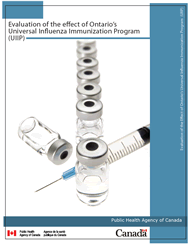
|
Table of Contents
- Background
-
Effect of Ontario's UIIP on Vaccination Rates
- Overview of methods
- Summary of results
- Study limitations
-
Effect of Ontario's UIIP Mortality and Health Care Use
- Overview of methods
- Summary of results
- Study limitations
- Discussion: Implications of Ontario's UIIP
- References
- Acknowledgements
Background
Annual epidemics of influenza continue to cause worldwide morbidity, mortality and societal disruption. Efforts to reduce the impact of influenza have mainly involved targeted influenza immunization programs (TIIP), which aim to vaccinate those at high risk of complications from influenza infection and their contacts.(1; 2)
In October 2000, Ontario initiated the world's first large-scale universal influenza immunization program (UIIP) to provide free influenza vaccinations for the entire population 6 months of age or older (3). Supporters have argued that universal programs have myriad benefits: increased personal protection from influenza; herd immunity arising from vaccinating greater proportions of the population; and having vaccine procurement and delivery systems in place for an influenza pandemic (4). Critics have argued that uncertainties surrounding both the effectiveness and the cost-effectiveness of vaccinating healthy adults and children may not justify the costs of implementing such programs (5).
Ontario was the lone province to implement a UIIP; other provinces maintained TIIPs. This provided an opportunity to conduct a series of quasi-experimental observational studies with Ontario as the intervention province and other provinces as controls.
TIIPs traditionally involve centralized vaccine procurement by provincial governments with publicly-insured local delivery to high risk individuals and their close contacts/care providers. Vaccine is delivered in health care settings by nurses or physicians, or in community settings through public health departments. High risk individuals include seniors aged 65 years or older, individuals with chronic medical conditions, children aged 6-23 months, and pregnant women (6). UIIP introduction in Ontario entailed expansion of prior vaccination activities, with local variations in delivery. Vaccine delivery settings include physician offices, hospitals, schools, workplaces, pharmacies, community centres and shopping malls. The program also includes extensive media campaigns promoting the availability and benefits of free influenza vaccinations.
In this report, we present a summary of our efforts to evaluate the effect of Ontario's UIIP on influenza vaccination rates and health outcomes (mortality, hospitalizations, emergency department (ED) use, and visits to doctors' offices). Following this introductory section, the report is divided into two sections, each containing methods, results, and limitations, and concludes with a brief discussion. For more detail, please read the associated scientific papers referred to in the respective sections.
Effect of Ontario's UIIP on Vaccination Rates
Overview of methods
Data from the 1996/1997 National Population Health Survey and the 2000/2001, 2003, and 2005 Canadian Community Health Survey were used to assess influenza vaccination rates of the household population aged 12 years or older. These surveys had response rates of between 79% and 85%.
Survey respondents who reported having had a flu shot within the last 12 months were considered to be actively immunized. Respondents who reported having heart disease, diabetes, cancer, effects of stroke, asthma, or emphysema/chronic bronchitis were considered to have a chronic condition for which influenza immunization is recommended.
Cross-tabulations were used to estimate the proportion of people who reported influenza vaccination in the previous year. Logistic regression models were used to examine the odds of being vaccinated in Ontario compared with other provinces that did not introduce universal influenza vaccination. These models were stratified by age group (12 to 49, 50 to 64, and 65 or older) and chronic condition status, and adjusted for age as a continuous variable, sex, household income, smoking status, having a regular doctor, and self-perceived health status.
Summary of results
Influenza vaccination rates for the household population aged 12 or older increased 24% (18% to 42%) for Ontario between 1996/1997 and 2005, compared to 15% (13% to 28%) for other provinces (p<0.001) (Figure 1).
Figure 1
Percentage vaccinated for influenza, household population aged 12 or older, Ontario versus other provinces combined, 1996/1997, 2000/2001, 2003 and 2005
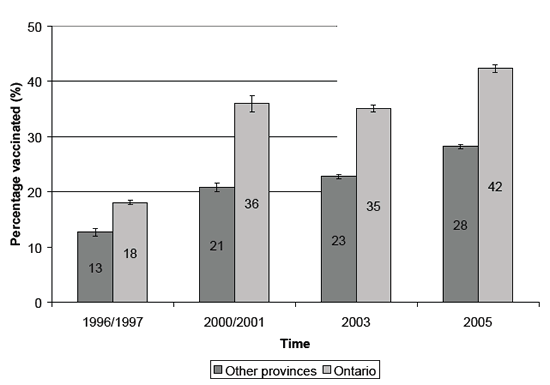
Among all age groups, with and without chronic conditions, vaccination rates in Ontario were higher than other provinces at all four survey dates (Figure 2). For those aged 12 to 49, the gap between Ontario and other provinces that appeared in 2000/2001 was reduced slightly among those with chronic conditions, but not for those without. A similar pattern was evident for 50 to 64 year-olds. For older adults, the difference between Ontario and other provinces has narrowed slightly over time.
Figure 2
Percentage vaccinated for influenza by age group and presence of chronic conditions, household population aged 12 or older, Ontario versus other provinces combined, 1996/1997,2000/2001, 2003 and 2005

Sources: 1996/1997 National population Health Survey; 2000/2001 Canadian Community Health Survey, cycle 1.1(fourth quarter); 2003 Canadian Community Health Survey cycle 2.1; 2005 Canadian Community Health Survey, cycle 3.1.
Figure 3
Adjusted odds ratios for influenza vaccination, by age group and presence of chronic conditions, household population aged 12 or older, Ontario versus other provinces combined, 1996/1997,2000/2001, 2003 and 2005
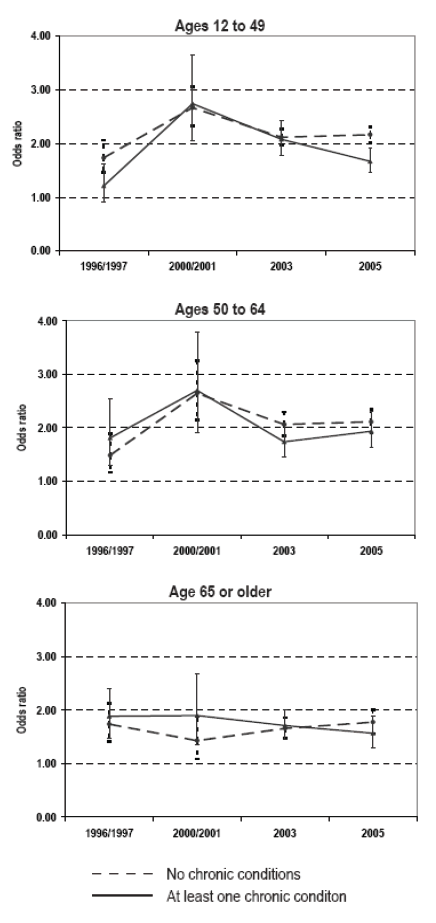
I = 95% confidence interval
Note: Adjusted for sex, age group and presence of chronic conditions, household income, smoking status, having regular doctor, self reported health and province/territory.
Sources: 1996/1997 National population Health Survey ; 2000/2001 Canadian Community Health Survey, cycle 1.1 (fourth quarter); 2003 Canadian Community Health Survey, cycle 2.1; 2005 Canadian Community Health Survey, cycle 3.1.
In the adjusted analyses, the odds of vaccination were almost always significantly greater for Ontarians, compared with residents of the other provinces (Figure 3). Among people aged 12 to 49 with chronic conditions, the OR increased from 1.21 (95% confidence interval [C.I.], 0.91-1.62) in 1996/1997 to 2.74 (95% C.I., 2.06-3.65) in 2000/2001, but then declined to 1.67 (95% C.I., 1.45-1.91) by 2005, suggesting some “catch-up” by other provinces. A similar pattern was observed for those aged 12 to 49 and 50 to 64 without chronic conditions. The differences between the surveys for 50 to 64 year-olds with chronic conditions were not statistically significant, likely because of the smaller sample size. As expected, relatively few differences over time were noted for those aged 65 or older, since seniors have traditionally been included in most targeted vaccination programs.
When the population was divided into finer age categories (Table 1), we observed that for those under 65 years, the increases were greater in Ontario than in other provinces, while for those 85 years or older, the increase was smaller in Ontario – likely because Ontario had high vaccination rates to begin with. For all age groups, Ontario always achieved higher vaccination rates than other provinces.
In summary, compared to targeted programs in other provinces, UIIP introduction in Ontario was associated with greater increases in vaccination rates over-all, particularly in those under 65 years, with or without chronic conditions. Among older age groups, other provinces achieved some “catch-up” compared to Ontario.
Table 1
Influenza vaccination rates over time for Ontario and other provinces
| Influenza vaccination rates (%) (95% CI) | |||||||||||||
|---|---|---|---|---|---|---|---|---|---|---|---|---|---|
| Age group | 1996-97 | 2000-01 | 2003 | 2005 | Mean post-UIIP* | Change** (percentage points) | p value‡ | ||||||
| Overall | |||||||||||||
| Ontario | 18 | (18-19) | 36 | (35-37) | 35 | (34-36) | 42 | (42-43) | 38 | (37-38) | 20 | (19-20) | <0.001 |
| Other provinces |
13 | (12-13) | 21 | (20-22) | 23 | (22-23) | 28 | (28-29) | 24 | (24-24) | 11 | (10-12) | |
| Atlantic provinces† | 16 | (14-17) | 19 | (18-20) | 24 | (24-25) | 31 | (30-32) | 25 | (24-25) | 9 | (7-10) | |
| Quebec | 8 | (7-9) | 18 | (17-20) | 20 | (19-21) | 25 | (24-26) | 21 | (20-22) | 13 | (12-14) | |
| Manitoba | 14 | (13-16) | 22 | (19-25) | 20 | (19-21) | 28 | (27-30) | 23 | (22-25) | 9 | (7-10) | |
| Saskatchewan | 13 | (11-15) | 19 | (17-21) | 24 | (22-25) | 28 | (27-30) | 24 | (23-25) | 10 | (8-13) | |
| Alberta | 15 | (15-16) | 23 | (21-25) | 23 | (22-24) | 28 | (27-29) | 25 | (24-26) | 9 | (8-10) | |
| British Columbia |
17 | (15-19) | 26 | (24-28) | 27 | (26-28) | 33 | (32-34) | 29 | (28-29) | 11 | (9-13) | |
| 12-19 years | |||||||||||||
| Ontario | 16 | (14-17) | 29 | (25-32) | 28 | (26-30) | 37 | (35-38) | 31 | (30-33) | 15 | (13-17) | <0.001 |
| Other provinces |
6 | (4-7) | 9 | (8-11) | 10 | (9-11) | 14 | (13-15) | 11 | (10-12) | 5 | (4-7) | |
| 20-49 years | |||||||||||||
| Ontario | 8 | (8-8) | 27 | (25-28) | 23 | (22-24) | 30 | (29-31) | 27 | (26-27) | 19 | (18-20) | <0.001 |
| Other provinces |
6 | (5-6) | 12 | (11-13) | 13 | (12-13) | 18 | (17-19) | 14 | (14-15) | 9 | (8-9) | |
| 50-64 years | |||||||||||||
| Ontario | 21 | (19-22) | 42 | (39-45) | 45 | (44-47) | 54 | (52-55) | 47 | (46-48) | 26 | (25-28) | <0.001 |
| Other provinces |
15 | (13-16) | 23 | (21-24) | 29 | (28-30) | 35 | (34-36) | 29 | (28-30) | 14 | (12-16) | |
| 65-74 years | |||||||||||||
| Ontario | 54 | (52-56) | 69 | (65-74) | 71 | (69-72) | 73 | (71-75) | 71 | (69-73) | 17 | (14-19) | 0.86 |
| Other provinces |
42 | (39-46) | 58 | (55-61) | 59 | (57-60) | 62 | (61-63) | 59 | (58-61) | 17 | (13-21) | |
| 75-84 years | |||||||||||||
| Ontario | 70 | (67-72) | 79 | (74-83) | 80 | (78-82) | 84 | (82-85) | 81 | (79-82) | 11 | (8-14) | 0.048 |
| Other provinces |
54 | (49-59) | 71 | (68-74) | 68 | (67-70) | 73 | (72-75) | 71 | (69-72) | 17 | (12-22) | |
| 85 years or older | |||||||||||||
| Ontario | 67 | (61-73) | 73 | (63-84) | 78 | (74-83) | 82 | (77-86) | 78 | (74-82) | 11 | (3-18) | 0.01 |
| Other provinces |
44 | (33-55) | 71 | (64-77) | 71 | (67-74) | 76 | (73-78) | 72 | (70-75) | 28 | (17-40) | |
| * UIIP = universal influenza immunization program in Ontario. ** Change represents absolute percentage point difference between mean of the 2000-01, 2003, and 2005 rates (post-UIIP) and the 1996/97 rate (pre-UIIP). ‡ p value for difference between the change over time in Ontario and other provinces combined. †Atlantic Provinces = Newfoundland and Labrador, Nova Scotia, New Brunswick, Prince Edward Island |
|||||||||||||
Study limitations
- Surveys excluded children younger than 12 and institutionalized elderly
- Surveys did not ask about all important chronic conditions for which influenza vaccination is indicated
- Survey responses cannot be confirmed
- Data are cross-sectional
For more details, please see:
- Kwong JC, Sambell C, Johansen H, Stukel TA, Manuel DG. The effect of universal influenza immunization on vaccination rates in Ontario. Health Reports (Statistics Canada, Catalogue 82-003) 2006;17(2):31-40.
- Kwong JC, Rosella LC, Johansen H. Trends in influenza vaccination in Canada, 1996/97 to 2005. Health Reports (Statistics Canada, Catalogue 82-003) 2007;18(4):1-11.
Effect of Ontario`s UIIP Mortality and Health Care Use
Overview of methods
Mortality data were obtained from Statistics Canada's Mortality Database, a national vital statistics dataset. Hospitalization data were obtained from Statistics Canada's Hospital Morbidity Database, a national discharge abstract dataset. Physician services data for visits to emergency departments (EDs) and doctors' offices were obtained from Ontario, Quebec, Alberta, and Manitoba, four provinces with comprehensive datasets. The primary outcomes were all-cause mortality, pneumonia and influenza (P&I) hospitalizations and visits to EDs and doctors' offices.
The primary study period was August 24, 1997 and August 14, 2004, comprising seven 52 week periods. Periods of peak influenza activity were defined as starting when the weekly percentage of tests positive for influenza was greater than 10% and ending when the percentage fell below that threshold for 2 consecutive weeks.
We estimated influenza-associated outcomes using a two-step procedure: we first ran multivariate regression models to estimate weekly event rates and to generate a baseline representing the hypothetical absence of influenza, and then we computed influenza-associated events by subtracting the predicted baseline from the observed events during periods of peak influenza activity (Figure 4). The Poisson regression models controlled for age; sex; viral surveillance for influenza A, influenza B and RSV; the seasonal percentage of A(H3N2) isolates and percentage of circulating strain mismatched to vaccine strains; polynomial (linear and quadratic) terms to model annual trends; sine and cosine terms to model seasonal fluctuations; and fluctuations in health care service delivery during Christmas holiday and immediate post-Christmas holiday periods (for health care use outcomes).
Figure 4
Influenza virus activity, observed P&I hospitalizations in Ontario females aged 85 or older, baseline hospitalizations without influenza, and estimates of influenza-associated events, 1997 to 2004.
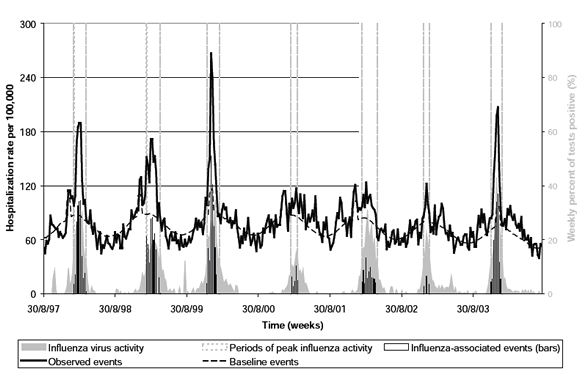
Overall and age-specific mean annual rates of influenza-associated outcomes were calculated for the periods before and after introduction of UIIP, for Ontario and for the other provinces combined. The relative rate (RR) was computed by dividing the post-intervention rate by the pre-intervention rate. The ratio of the RRs for Ontario and other provinces combined were compared using the z-test.
Summary of results
The time series plots of weekly event rates over the study period for Ontario and other provinces combined demonstrated seasonal trends with spikes during periods of influenza activity (Figure 5).
Figure 5
Study outcome rates and influenza vaccination rates for Ontario and other provinces combined, and influenza viral surveillance for Ontario.
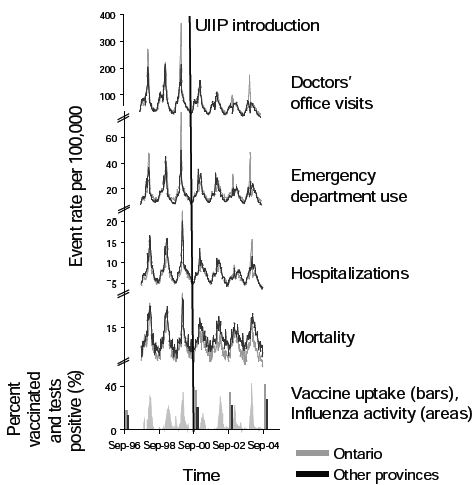
After UIIP introduction, influenza-associated all-cause mortality for the overall population decreased 74% in Ontario (relative rate=0.26, 95% CI, 0.20-0.34) compared to 57% in other provinces (RR=0.43, 95% CI, 0.37-0.50) (ratio of RRs=0.61, p=0.002) (Table 2). In age-specific analyses, larger decreases in Ontario were seen only in those 85 years or older.
Overall, influenza-associated health care use for P&I decreased more in Ontario than other provinces for hospitalizations (RR=0.25 vs. 0.44, ratio of RRs=0.58, p<0.001), ED use (RR=0.31 vs. 0.70, ratio of RRs=0.45, p<0.001), and doctors' office visits (RR=0.21 vs. 0.53, ratio of RRs=0.41, p<0.001). In age-specific analyses, greater decreases were consistently observed in Ontario than other provinces for age groups younger than 65 years. For seniors, greater decreases were observed in Ontario than other provinces for hospitalizations among those aged 65-84 years and for ED use among those 65-74 years.
Table 2
Effect of UIIP on influenza-associated mortality and health care use rates.
| Mean annual influenza-associated event rates (per 100,000) | Ratio of Ontario /Other RRs |
p value* | ||||||
| Age groups (years) |
Ontario | Other provinces combined | ||||||
| Pre-2000 | Post-2000 | Post vs. pre RR† (95% CI) |
Pre-2000 | Post-2000 | Post vs. pre RR† (95% CI) |
|||
| All-cause mortality | ||||||||
| All ages | 14.8 | 3.9 | 0.26 (0.20-0.34) | 16.1 | 6.9 | 0.43 (0.37-0.50) | 0.61 | 0.002 |
| < 50 | 0.8 | 0.4 | 0.42 (0.13-1.42) | 0.6 | 0.5 | 0.81 (0.28-2.34) | 0.52 | 0.43 |
| 50-64 | 3.9 | 1.3 | 0.34 (0.06-2.02) | 5.1 | 0.3 | 0.07 (0-23.46) | 4.96 | 0.61 |
| 65-74 | 24.7 | 6.2 | 0.25 (0.09-0.70) | 33.0 | 11.8 | 0.36 (0.21-0.61) | 0.71 | 0.55 |
| 75-84 | 126.5 | 28.4 | 0.22 (0.14-0.36) | 144.9 | 44.7 | 0.31 (0.23-0.41) | 0.73 | 0.25 |
| 85+ | 562.8 | 134.3 | 0.24 (0.17-0.33) | 525.4 | 255.8 | 0.49 (0.41-0.58) | 0.49 | <0.001 |
| Pneumonia and influenza hospitalizations | ||||||||
| All ages | 33.4 | 8.5 | 0.25 (0.23-0.28) | 44.9 | 19.8 | 0.44 (0.42-0.46) | 0.58 | <0.001 |
| < 5 | 44.5 | 23.6 | 0.53 (0.41-0.68) | 44.3 | 59.9 | 1.35 (1.14-1.60) | 0.39 | <0.001 |
| 5-19 | 2.1 | 1.3 | 0.63 (0.29-1.39) | 2.0 | 5.0 | 2.56 (1.42-4.61) | 0.25 | 0.005 |
| 20-49 | 6.0 | 1.2 | 0.21 (0.13-0.32) | 10.5 | 5.9 | 0.56 (0.50-0.63) | 0.37 | <0.001 |
| 50-64 | 25.4 | 2.0 | 0.08 (0.03-0.18) | 44.4 | 15.8 | 0.36 (0.32-0.40) | 0.22 | <0.001 |
| 65-74 | 88.8 | 15.2 | 0.17 (0.12-0.23) | 134.6 | 39.1 | 0.29 (0.26-0.33) | 0.59 | 0.002 |
| 75-84 | 258.8 | 57.2 | 0.22 (0.19-0.26) | 318.6 | 93.2 | 0.29 (0.27-0.32) | 0.76 | 0.006 |
| 85+ | 564.6 | 188.5 | 0.33 (0.29-0.39) | 621.9 | 240.2 | 0.39 (0.35-0.43) | 0.86 | 0.12 |
| Pneumonia and influenza emergency department use | ||||||||
| All ages | 139.6 | 43.6 | 0.31 (0.30-0.32) | 125.0 | 85.9 | 0.69 (0.67-0.70) | 0.45 | <0.001 |
| < 5 | 267.9 | 149.6 | 0.56 (0.51-0.61) | 134.2 | 214.9 | 1.60 (1.43-1.79) | 0.35 | <0.001 |
| 5-19 | 93.8 | 48.4 | 0.52 (0.48-0.55) | 54.5 | 98.5 | 1.81 (1.68-1.94) | 0.29 | <0.001 |
| 20-49 | 88.3 | 22.8 | 0.26 (0.24-0.28) | 94.9 | 70.4 | 0.74 (0.72-0.77) | 0.35 | <0.001 |
| 50-64 | 131.8 | 17.0 | 0.13 (0.11-0.15) | 145.4 | 54.4 | 0.37 (0.35-0.40) | 0.34 | <0.001 |
| 65-74 | 215.9 | 48.7 | 0.23 (0.20-0.26) | 213.4 | 66.1 | 0.31 (0.28-0.34) | 0.73 | <0.001 |
| 75-84 | 431.1 | 107.0 | 0.25 (0.22-0.28) | 423.7 | 115.6 | 0.27 (0.25-0.30) | 0.91 | 0.26 |
| 85+ | 853.1 | 308.4 | 0.36 (0.32-0.41) | 732.2 | 303.0 | 0.41 (0.37-0.46) | 0.87 | 0.10 |
| Pneumonia and influenza doctors' office visits | ||||||||
| All ages | 813.6 | 173.0 | 0.21 (0.21-0.22) | 587.7 | 306.2 | 0.52 (0.51-0.53) | 0.41 | <0.001 |
| < 5 | 1007.0 | 368.5 | 0.37 (0.35-0.39) | 479.8 | 596.6 | 1.24 (1.16-1.33) | 0.29 | <0.001 |
| 5-19 | 637.4 | 274.9 | 0.43 (0.42-0.44) | 430.2 | 481.7 | 1.12 (1.09-1.15) | 0.39 | <0.001 |
| 20-49 | 705.0 | 121.4 | 0.17 (0.17-0.18) | 586.0 | 286.5 | 0.49 (0.48-0.50) | 0.35 | <0.001 |
| 50-64 | 935.7 | 87.3 | 0.09 (0.09-0.10) | 787.7 | 207.3 | 0.26 (0.25-0.27) | 0.35 | <0.001 |
| 65-74 | 928.5 | 120.9 | 0.13 (0.12-0.14) | 605.5 | 89.3 | 0.15 (0.13-0.17) | 0.88 | 0.14 |
| 75-84 | 1440.1 | 245.5 | 0.17 (0.16-0.18) | 720.9 | 109.3 | 0.15 (0.13-0.18) | 1.12 | 0.16 |
| 85+ | 2610.1 | 614.7 | 0.24 (0.22-0.25) | 835.9 | 164.5 | 0.02 (0.17-0.23) | 1.20 | 0.06 |
| † Relative rate. * p value for comparison between post vs. pre relative rates for Ontario and other provinces combined. |
||||||||
In summary, compared to targeted programs in other provinces, UIIP introduction in Ontario was associated with greater decreases in mortality from all causes and hospitalizations, ED use, and doctors' office visits for pneumonia and influenza.
Study limitations
- Non-specific outcome measures – outcomes may have been due to causes other than influenza. To address this, we:
- Used most specific outcomes (i.e., P&I hospitalizations), except for mortality
- Estimated influenza-associated events using advanced statistical modeling techniques
- Only included events during peak influenza season periods
- Influenza-associated events are derived from statistical models and may not necessarily reflect reality; they represent, at best, an approximation
- Unavailability of individual-level vaccination and outcome data necessitated the use of ecological studies that may be susceptible to ecological fallacy
- Laboratory viral surveillance data may be susceptible to ascertainment and reporting biases
- No vaccination rate data are available for those under 12 years of age or for institutionalized seniors
- Unable to control for other potential confounders: prevalence of individual comorbidities, socioeconomic status, smoking rates, health care system capacity, polysaccharide or conjugated pneumococcal vaccination, antiviral medication use, but we have no reason to believe that these factors changed more over time in Ontario compared to other provinces
- Possibility of “healthy population” bias (i.e., healthier populations are more likely to get vaccinated and have better outcomes)
- Unable to determine extent of direct vs. indirect benefits of influenza vaccination
For more details, please see:
- Kwong JC, Stukel TA, Schanzer DL, Lim J, McGeer AJ, Upshur REG, Johan-sen H, Sambell C, Thompson WW, Thiruchelvam D, Marra F, Svenson LW, Manuel DG. The effect of universal influenza immunization on mortality and health care use. Manuscript under review.
Discussion: Implications of Ontario's UIIP
Introduction of the Universal Influenza Immunization Program in Ontario has been associated with increased vaccine uptake and decreased influenza-associated mortality, hospitalizations, emergency department use, and doctors' office visits, when compared to provinces that maintained targeted programs. Age-specific analyses demonstrated greater drops in health care use over time in Ontario compared to other provinces for younger age groups, with no or less of a difference among older age groups. This is consistent with the age-specific pattern for temporal changes in vaccine uptake, with greater increases over time in Ontario compared to other provinces for younger age groups leading to greater expectations of benefits from the UIIP. However, greater incremental increases in vaccine uptake in other provinces compared to Ontario were observed for older age groups, particularly those 75 years or older, yet among all the outcomes, none of the RR ratios were greater than one. This suggests that either influenza vaccination is less effective in the elderly, or there are indirect benefits resulting from vaccinating a greater proportion of the younger age groups. Unfortunately, this study does not permit determination of the direct versus indirect benefits of universal vaccination.
Readers should be cautious in interpreting the results, taking into consideration the various limita-tions of these analyses outlined in the above sections. It is possible that the observed changes could have been the result of factors other than introduction of Ontario's UIIP. Conversely, there exist alternatives to introducing universal vaccination. For example, certain provinces and territories have achieved high vaccination rates of their high-risk populations without implementing universal vaccination programs (7). In contrast, Yukon has had a universal program since 1999 but achieves low vaccination rates compared to the other territories. Therefore, the results achieved in Ontario may not be seen in other jurisdictions that implement a UIIP.
Although it is beyond the scope of this report, there may be other benefits associated with a UIIP. Anecdotally, UIIP introduction in Ontario has led to improved processes and infrastructure that may enhance pandemic influenza preparedness. Health care and public health staff have become accustomed to mass delivery of influenza vaccines on an annual basis, and the public is attuned to the extensive media campaigns promoting the availability and importance of influenza vaccinations.
Future work should include economic evaluations to determine the cost-effectiveness of UIIP versus TIIP, and these studies are under way. In Phase 2 of the UIIP Evaluation that is currently being funded by the Canadian Institutes for Health Research, our team will conduct a number of studies, some of which will repeat the analyses in this report, but with additional influenza seasons to determine if the effects observed in these analyses are sustained.
In light of limited health care and public health resources, each jurisdiction will need to decide whether introducing universal influenza vaccination is appropriate for their population. The findings in this report suggest that introduction of Ontario's UIIP in 2000 has been associated with both increases in vaccine uptake and decreases in a wide range of health outcomes. It is possible that other jurisdictions may experience comparable health benefits by implementing universal vaccination programs.
References
- Fiore AE, Shay DK, Haber P, Iskander JK, Uyeki TM, Mootrey G et al. Prevention and control of influenza. Recommendations of the Advisory Commit-tee on Immunization Practices (ACIP), 2007. Morbidity & Mortality Weekly Report Recommendations & Reports 56(RR-6):1-54, 2007.
- National Advisory Committee on Immunization (NACI). Statement on influenza vaccination for the 2007-2008 season. An Advisory Committee Statement (ACS). Canada Communicable Disease Report 2007; 33(ACS-7):1-38.
- Canada NewsWire. Ontario invests $38 million to ease emergency room pressures with universal vaccination program. http://ogov.newswire.ca/ontario/GPOE/2000/07/25/c6018.html?lmatch=&lang=_e.html
. 25-7-2000. 9-7-2007. - Schabas RE. Mass influenza vaccination in Ontario: a sensible move. Canadian Medical Association Journal 2001; 164(1):36-7.
- Demicheli V. Mass influenza vaccination in Ontario: is it worthwhile? Canadian Medical Association Journal 2001; 164(1):38-9.
- Langley JM, National Advisory Committee on Immunization. State-ment on influenza vaccination for the 2006-2007 season. Canada Communicable Disease Report 2006; 32(ACS-7):1-28.
- Kwong JC, Rosella LC, Johansen H. Trends in influenza vaccination in Canada, 1996/97 to 2005. Health Reports (Statistics Canada, Catalogue 82-003) 2007; 18(4):1-11.
Acknowledgements
Institute for Clinical Evaluative Sciences Mount Sinai Hospital, Toronto Manitoba Centre for Health Policy Alberta Health & Wellness |
BC Centre for Disease Control Statistics Canada Public Health Agency of Canada Centers for Disease Control and Prevention, Atlanta |
